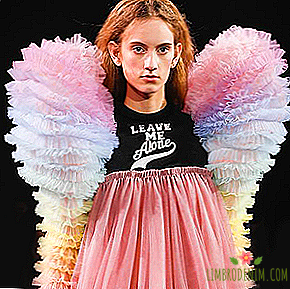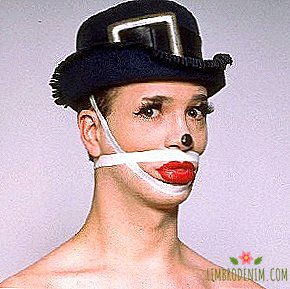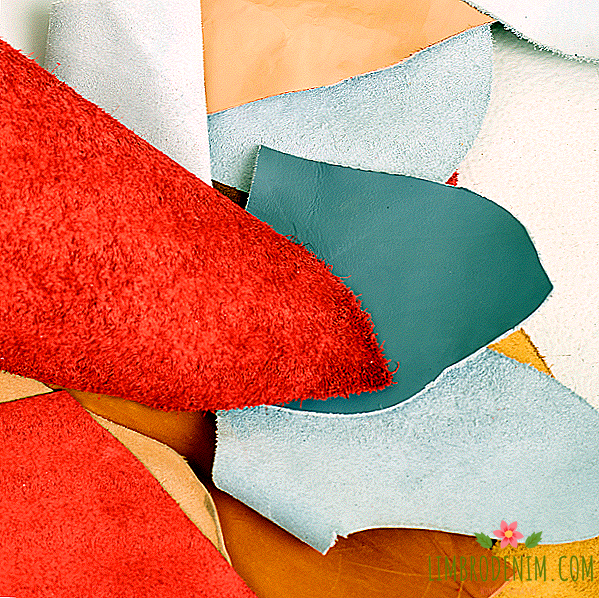Marina Abramovich: The Rock Star of Modern Art
Tomorrow marks 70th anniversary of Marina Abramovich - one of the most influential people in contemporary art, who became a living classic long before they began to call her the "grandmother of performance". For more than forty years, Abramovich has been exploring the limits of his physical and mental abilities - speaking of her, it is easy to strike into pathos and blind adoration. But knowing a little more about her life, it is not difficult to understand that behind bold and often shocking performances is a living woman of flesh and blood, who has come a long way from an unsure Yugoslav teenager to a wise adult who has finally found harmony with herself.

“Do you know what's interesting? At first, for forty years they think that you are crazy, that you need to be treated, and then you get recognition. You have to spend a lot of time to be taken seriously,” said Abramovich with a smile before opening his epochal retrospective in MoMA. All those who personally communicated with the artist, note how easy and pleasantly felt in her company: it is hard to believe that a person who is so tough with his body and mind can be so cheerful and easy to talk to. If before the film “In the Presence of an Artist”, Abramovich was simply very famous, now she is a rock star of performance, literally a living icon, which is respected even by people who are far from modern art. The artist willingly calls herself a “grandmother of a performance” and acknowledges that she likes celebrity status — after all, everything Abramovich ever did was based on energy exchange with the public, without which performance is impossible, and widespread recognition is a sign that all her work was not in vain.
Marina Abramovich’s childhood can hardly be called ordinary: her parents, Voio and Danitsa, are Yugoslav partisans who met during the war and after it ended became national heroes. The life of the Abramovich family, which had a large apartment, famous friends, honorary positions and privileges from the state, was not like the life of other Yugoslav families. Despite the external well-being, Marina constantly felt lonely: the stern mother who led the Museum of the Revolution was so afraid to pamper children that she never embraced them, and even after the divorce she kept the usual army order in the house. At the same time, Danitsa herself was interested in art and supported her daughter’s desire to practice them, but in her ideas creativity in an absurd way coexisted with total parental control.
“I was not allowed to leave the house after ten o'clock in the evening until the age of 29,” says Abramovich. “I performed all the performances in Yugoslavia until ten o'clock in the evening because it was supposed to be at that time. It was absolutely insane, but all my cuts , whipping, burning, which could take away my life - everything was done until ten in the evening. " Her upbringing is a strange cocktail from communism to which the parents of Christianity and Balkan culture were faithful, about which the girl had an idea thanks to a devout and very loving grandmother. This was reflected in the autobiographical performance of "Lips of Thomas", performed in 1975 and repeated in 2002, Abramovich ate a kilogram of honey before the public, drank a liter of wine, smashed a bottle, cut out a five-pointed star on his stomach, and then lay on an icy cross .
← Performance "Rhythm 0"
Abramovich’s very first performance, Rhythm 10, was inspired by the Russian prison game with a knife. The artist took turns taking one of the twenty knives in front of her and quickly stuck it in the space between her fingers, changing the knife after each cut, and then started all over again, making cuts in the same places where she stumbled last time - the performance is devoted to mistakes repeat over and over again. Then the artist was convinced that she did not need any tools other than her own body, and the unusual contact that is established between the artist and the public looking at him here and now is the most honest dialogue that you can imagine.
“Before the eyes of the audience, I’m not afraid to feel old, fat, ugly, I can safely undress - because only the body is important as a tool, only the concept of performance,” explains Abramovich. At home, on the red carpet or in bed with a man, she may feel ugly and awkward, ashamed of her nose or chest, but this has nothing to do with nudity during a performance.
In the process of creating her art, Abramovich was unusually persistent, but the cuts that she inflicted on herself during a performative trance were taken by an “earthly”, not so fearless Marina. Some actions turned out to be no less shocking for her than for the public: Abramovich told that after the infamous performance of "Rhythm 0" she came home completely devastated and found a strand of gray hair. But after, having healed the cuts and thought about what had happened, Abramovich continued to stoically test himself. It is not difficult for her to establish contact with the audience simply by standing on the stage and talking to the crowd (as, for example, in a short TED performance), but as an artist she needs a special, deep dialogue with the audience: for Abramovich, performance is a ritual in which the body that accepts certain posture or performing a sequence of actions, talks about death, trust, cleansing, peace and strength of mind. The artist explains that during the performance she turns into another person who is fed by the energy of the public and perceives pain in a completely different way than in ordinary life.
She starved, beat herself with a lash, ran into a wall with a run, but in fact never had a chance of self-destruction - Abramovich makes fun of the fact that she was never a "bohemian" artist, did not experience problems with drugs or alcohol, and now she lives very simple and even boring. The body for Abramovich has always been a "starting point in spiritual development" - a tool that is necessary for the esoteric study of human capabilities. Having chosen her own body as the main subject and media, Abramovich brought the performance genre to a new level: looking at how Marina puts herself to various challenges and seeing her naked body, blood and tears, the viewer touches (sometimes literally) on such complex topics as personal boundaries , acceptance and trust, moral and physical resilience, the fragility of life and the inevitability of death.

↑ Performance "Rhythm 5"
The principle that Abramovich followed all her life was to bring everything to the limit, to the very end, be it a risky performance or a stormy romance. Three minutes after the start of the performance "Rhythm 4" with a strong air flow directed into her face, Abramovich fainted, in "Rhythm 5" the audience pulled the artist out of the fiery contour in the form of a star, as she lost consciousness due to lack of oxygen . Marina was always merciless to her flesh and often appeared naked, but during one of her most intense and risky performances she was fully dressed, barely moving, and not in pain - at least physical. Speech about "Energy of rest" - four infinite minutes, during which the artist herself holds a bow, and her beloved Uli - an arrow directed at her heart.
Marina met Ulaem in Amsterdam in 1976, and for twelve years they were inseparable - both describe their union as complete merging, endless trust and dissolution in each other, one thought and one art for two. Thanks to their symbiotic relationship, Abramovich and Ulay created a series of piercing performances about relationships: they shouted that there was urine, crashed into each other, checking whether their bodies could merge into one, tested their patience, sitting motionless with tied hair, and literally breathing each other until oxygen ran out. After twelve years of intense and difficult relationships, the artists also turned their parting into a performance — a solemn and sad ritual: Marina and Ulay set off from opposite ends of the Great Wall of China and traveled two and a half thousand kilometers before meeting in the middle, embracing and leaving.
There was a lot of pain in this relationship. While superhuman artists created their powerful performances, artists - ordinary men and women swore, annoyed each other, suffered from a lack of personal space, money and jealousy. Although after the breakup, Ulai and Marina met more than once, and their "reunion" was one of the highlights of the exhibition "In the presence of the artist", the relationship of former lovers is not at all as sublime as the idea of their perfect farewell on the Great Wall of China: recently Ulay sued Abramovich has two hundred and fifty thousand euros, accusing her of illegally using their common works.
The artist does not cover the intimate details of their life together, but for some remarks it is clear that Ulay controlled all monetary and organizational issues, leaving his companion "on the farm": while Ulay agreed with gallery owners, Marina knitted sweaters for sale so that the artists would not starve. Abramovich herself says that for several years she was absolutely happy, but over time the relationship became more complicated: what was initially perceived as absolute mutual understanding and common world outlook turned into a painful co-dependency, from which both suffered. The performance with the Great Wall of China was conceived as a wedding ceremony, but after several years of preparation, the artists decided that it was time for them to leave, and not marry. By the beginning of the trip, Abramovich had learned that their Chinese translator was pregnant by Ulai.
← "Manifesto of the artist's life"
The pain of betrayal returned the artist to the state of "an ordinary woman" unloved by her - she felt weak and devastated, "ugly, fat and unwanted." But if Marina - an ordinary person was confused and sad, then the artist inside her became even stronger. "If I feel so bad, I have to do something that is most disgusting to me," Abramovich told herself and decided to try herself in a theater that she always despised for falsity and subordination to the canons. Relations with Ulai, as well as with Nesha Paripovich and Paolo Kanevari, her husbands, became a lesson that Marina succinctly and ironically reflected in her “Manifesto of the artist’s life” - a set of rules that Abramovich advises to follow if you are seriously engaged in art. The section "The Attitude of the Artist to Love" consists of three points:
1. The artist should not fall in love with another artist.
2. The artist should not fall in love with another artist.
3. The artist should not fall in love with another artist.
When Reddit users asked Abramovich why this was so, she replied: "I did it three times in my life, and every time it all ended with my broken heart. I judge it from my own experience. This is a very competitive situation that is difficult to describe in two words And this is a subject for a long conversation. It is better to look at the artists who lived together (both in the past and now) and understand how tragic everything happened with them. "
One of the hardest performances of Abramovich was "The House with the Ocean View" - the artist spent twelve days without food on three platforms, "rooms" that the audience could constantly watch. After an illness caused by exhaustion, Abramovich decided to temporarily change his occupation. This is how the film “Balkan Erotic Epic” appeared - an artistic study and reproduction of traditional rituals involving female and male sex organs. For example, the ritual of “scaring away” the rain: when the downpour did not stop for several days, Balkan women ran out into the field and raised their skirts, showing the genitals to the skies. “Scare the gods with a vagina - how did they just think of it?”, Laughs Abramovich. Balkan culture is important for her, but Marina has long considered himself a man without a homeland: when asked where she comes from, the artist usually replies that there is no such country anymore. Abramovich is equally interested in the rituals of Montenegrins, Australian Aborigines, Indians, Brazilian mediums - a beautiful documentary "At a Crossroads: Marina Abramovich and Brazil" is dedicated to her esoteric search.

↑ Performance "Balkan Baroque"
Although many of the works of Abramovich are associated with nudity, corporeality, and relationships, she refuses to call her art "feminine" or "feminist." She believes that all this - labels that devalue the work of the artist. Nevertheless, in his performances and in an interview, Abramovich talks about the power of women: in the Balkan Baroque, the artist tries on the role of a mourner, washing a huge pile of bones from blood and meat residues, in 2012, she speaks to an audience of three thousand women and notes extraordinary energetic connection and sense of sisterhood. “I never wanted to have a male body,” said Abramovich in an interview. “It seems to me that women are stronger in any case. The very ability of a woman to give life makes her superhuman, and the rest is not important.” The artist herself deliberately refused motherhood: she recently confessed that she had made three abortions, because the birth of a child would be a "catastrophe" for her work. Abramovich says that now she is happy with her loneliness and freedom, but sometimes bitterness slips into her words: “Oh, do not worry, my husbands are leaving, my friends are leaving, they cannot cope with it, they cannot stand the intensity. I’m too much for whom it is unbearable. "
Perhaps the most amazing thing about Marina Abramovich is how incredible strength in her coexists with humanity, gentleness and vulnerability. In an interview, she talks about how she started going to a psychoanalyst, how she wanted to break her nose as a child, to make parents pay for plastic surgery (and eventually get a nose like Bridget Bardot), how her knees are shaking before important events ("If I’m not nervous, I’m getting nervous that I’m not nervous ").
She agrees to attach electrodes to her head, if it helps scientists learn more about the nature of the performance, and considers herself superstitious - Abramovich is sick only in red pajamas and red sheets, because she believes that this color restores vitality. She communicates with the idols of millennials, James Franco and Lady Gaga, loves expensive clothes and maintains a long-term friendship with Ricardo Tisci, acts in Givenchy campaigns and Antony & The Johnsons videos, tries to tell a joke about artists who turn a light bulb, consider themselves ugly and laughs at her mother, who pulled out all the naked photos from the catalogs of Marina’s exhibitions, “so that it would not be a shame to show the neighbors”. She cries - and then, on the Great Wall of China, and during her retrospective at MoMA, when the former lover comes to look into her eyes. “Suffering does not make you weak. When trouble comes, when you encounter difficulties, this is good stuff,” says Abramovich. “And if you survive all this, your art will only get better.” And he adds: "In ordinary life, I am joking a lot, because there is so much drama inside of me. If I am not funny, I will die."
Photo: MoMA, Marina Abramovic / Artists Rights Society (ARS), New York City / VG Bild-Kunst, Bonn, Marina Abramovic Courtesy Gallery, New York City Abramovic and Sean Gallery





